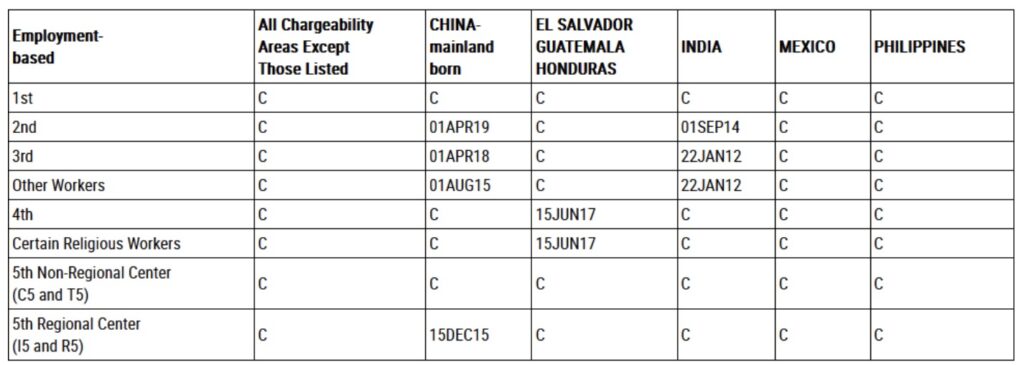Priority Dates and the Visa Bulletin
What is a priority date?
A priority date is the date that USCIS considers an individual to have officially declared their intent to
apply for permanent residency. Priority dates determine one’s place in line for a green card, and can be
found on either the I-130 or I-140 receipt notice.
The priority date in a family-based petition is the date on which the petition (Form I-130) has been
received by USCIS. The priority date in an employment-based petition is the date on which either the
Labor Certification has been received by the Department of Labor (for petitions where a Labor Certification is required) OR on the date that USCIS receives the petition (Form I-140), for petitions where no Labor Certification is required.
Why are priority dates necessary?
Pursuant to federal regulation, the U.S. reserves 226,000 green cards each year to people applying in all
family-based petitions other than immediate relative* petitions, which are unlimited. The 226,000 total is
divided between the 4 preference** categories remaining on the family-based side.
Employment based petitions are capped at 140,000*** each year, and they are divided between the 5
employment based preference categories. The 5 preference categories and Pitt’s most common petitions in each category are:
Priority workers (EB1A – Extraordinary Ability; EB1B – Outstanding Researcher/Professor)
Members of the profession holding advanced degrees (EB2B – Exceptional Ability; EB2C – National
Interest Waiver)
Skilled workers, professionals, and other workers
Certain Special Immigrants
Employment Creation
In addition to the overall limits, no one country can be granted more than 7% of the green cards in any given year. When any country is over proscribed in any given category, a waiting list is formed, and the priority dates are utilized to determine where the line begins and ends. Therefore, high-population countries like China and India will be more likely to have long waiting times, and their priority dates will be much earlier than others.
*Immediate relative petitions include spouses, unmarried children under 21, and parents of U.S. citizens.
**Family preference categories include petitions by citizens for their parents and adult children, and from
permanent residents for their spouses and children.
*** These numerical caps were set in 1990 and have not been adjusted since that time.
What are the current priority dates?
All priority dates are listed in the Visa Bulletin, which is managed by the Department of State. Priority
dates usually change from month to month, so it is wise to check the Bulletin each month to determine
eligibility for filing Form I-485.
USCIS updates this page each month to help individuals track their eligibility for filing their Form I-485
Adjustment of Status application.
How to Read the Visa Bulletin
- There are two charts listed in the Visa Bulletin for each category of green card – a Dates of Filing
chart and a Final Action Dates chart. First check here to see which chart to use in any given
month. Then go to the Visa Bulletin for the current month, and check the appropriate chart.
2. Determine whether your case is ‘Current’ by checking your case type (first column) along with your country of birth. For case type, 1st means any EB-1 case (e.g. EB-1b, EB-1a). 2nd means any EB- case (e.g. EB-2 PERM, EB-2 NIW).
**Note that spouses filing Forms I-485 together may be able to take advantage of ‘crosschargeability’, meaning the derivative spouse’s country of birth may be used to determine priority
date. (Example – EB-2 principal applicant is born in India, but her spouse is born in Canada. The
couple can claim that their priority date is current because Canada is not listed in Visa Bulletin as
back-logged. Form I-485 can be submitted.)
3. Case types that are ‘Current’ will be marked with a ‘C’, which means that the individual is free to
submit Form I-485 Adjustment of Status. Case types with a specific date are back-logged, and
USCIS will only accept Form I-485 for individuals with a priority date on or before that date listed
in the chart. If their priority date is not on or before the date listed, they must wait before filing
Form I-485, and should check the Visa Bulletin each month.
An employment-based sample is listed below.

Additional Resources
1. “Employment-Based Immigrant Visas.” U.S. Department of State.
2. “Employment-Based Visa Categories in the United States.” American Immigration Council, July 8, 2021.
3. “Explainer: How the U.S. Legal Immigration System Works.” Migration Policy Institute, April 2019.
4. “Green Card for Employment-Based Immigrants.” US Citizenship and Immigration Services, April 8, 2022